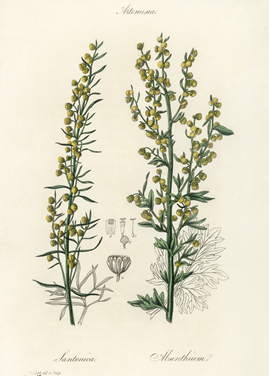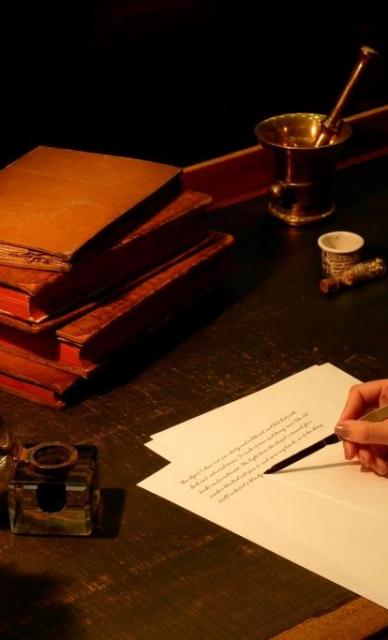Physicians' Gallery Newsletter
Updates on upcoming events, exhibitions and online stories
Empowering medical excellence, shaping healthcare futures.
Very early on, people discovered certain plants’ effects on the female body and developed the use of contraceptives, abortifacients, or even pregnancy tests with the plants’ help. Ancient historians and researchers on the history of medicine have long been researching and studying recipes and ingredients which members of ancient societies used for birth control.

There is some archaeological and written evidence of regularly used and trusted methods of contraception or early-term abortions, and it is speculated that silphion could have been effective. This is also known as laserwort or silphium, but was likely harvested to extinction in antiquity, so knowledge about it is scarce - Theophrastus (the “father of botany”) mentioned its suspected origins in his writings in 310 BC. Many of the sources that are available on ingredients for ancient birth control consist of second-hand knowledge.
Women practiced these methods but the vast majority of the records on them were written by men, and it was not a topic openly talked about in society. Some plants and their gynaecological uses are also linked closely to mythology and folklore. Artemis was often considered the goddess of women, the woodland, and the protector of childbirth. The plant named after her, Artemisia, still grows nowadays and was said to help against labour pains. In Dioscorides’ De Materia Medica, he lists a species of wormwood (Artemisia) as an antifertility drug.
Other plants said to have an effect on fertility and conception were, for example, Queen Anne’s lace (Daucus carota) or the squirting cucumber (Ecballium elaterium). In our Physicians’ Flowers exhibition, you can see a drawing of the Chinese Rose (Hibiscus rosa-sinensis) in James Edward Smith’s Gleanings of Botany, and the plant was said to work as a contraceptive as well. Scholars have also looked at the possibility of there being plans for a physic garden with a specific focus on gynaecology in Glasgow in the late 1600s.
There are additionally cases of plants and herbs’ other qualities being used for gynaecological purposes. For centuries, there was a belief that the womb would wander around in the body if something was not quite right with it. At some stage, it was even thought that the womb was a woman’s second nose and was attracted to ‘pleasant smells’ and was repulsed by ‘foul smells’. So, some believed that by having musk, laurel, and cloves burned in an incense burner and held under a woman’s skirt, these smells could rectify any odd positions the womb might be in.
It was also considered possible that being able to smell certain aromatic plants could determine whether or not a patient was pregnant, although this theory has since been challenged. By the late 1600s, this idea of using aromatic herbs for gynaecological treatment was thought to be nothing more than a quack remedy.
A scandalous education or polite pastime?
Gardens have often been considered ‘feminine’ places, however the actual study of plants in botany was still fairly male-dominated. Especially in the 1800s, botany became an increasingly ‘professionalised’ science, which meant that women’s participation was more frequently limited. There seemed to have been a constant back and forth whether botany should be considered a more masculine or feminine discipline.
In an edition of the journal Science in 1887, Dr. J.F.A. Adams wrote a defense of botany as a “manly study” and referred to the fact that it had previously been seen as “suitable enough for young ladies and effeminate youths” but not for “able-bodied and vigorous-brained young men”. It can be seen that the Enlightenment in the 1700s contributed to more and more women taking an interest in botany.
Some claimed that through Linnaeus’ new system of plant classification, published in his Systema Naturae in 1735, women could access an education that was more ‘scandalous’ than what they would usually be able to read. The Linnaean classification system was based on the female and male parts of plants and was on occasion called The Sexual System. He often wrote about plant species relationships by using analogies with human relationships, in particular marriage and wedding imagery.
Some English translations of Linnaeus’ work allegedly even struggled with finding ‘appropriate’ terminology for the sexual or anatomically explicit language. His work also inspired botanical literature, such as poet and naturalist Erasmus Darwin’s (grandfather of Charles Darwin) The Loves of the Plants, which featured the speaker as the Goddess of Botany.
Despite its broadening reach, botany remained very much a leisure activity for upper-class women. Women of the aristocracy were prominent in patronising and supporting botanical science and art. Queen Charlotte (1744-1818), for example, supported the botanic gardens at Kew, while Marianne North (1830-1890), daughter to member of parliament Frederick North, was able to travel abroad and draw and document the plants she encountered there.
A lot of the time, it was considered a ‘polite activity’ of an accomplished young lady, such as being well-read or able to speak French fluently. Prominent works by women emerging from this period are Elizabeth Blackwell's A Curious Herbal (1737-1739) or Priscilla Bell Wakelfield’s An Introduction to Botany (1796), the latter of which wrote in a letter-writing style to more easily convey her material in an educational way in order to promote the education about botany to broader groups, including women and children.
Author: Isabel Lauterjung
References:
- JH Dickson and WW Gauld. 1987. “Mark Jameson's Physic Plants, a Sixteenth Century Garden for Gynaecology in Glasgow?”, in Scottish Medical Journal, Vol. 32 (2), pp.60-62
- Jenny Uglow. 2002. “Sexing the plants”, in The Guardian [https://www.theguardian.com/books/2002/sep/21/featuresreviews.guardianr…]
- Henrietta Nickels Shirk. 1997. “Contributions to Botany, the Female Science, by Two Eighteenth-Century Women Technical Communicators”, in Technical Communication Quarterly, Vol. 6 (3), pp.293-312
- Alexandra Cook. 2007. “Botanical exchanges: Jean-Jacques Rousseau and the Duchess of Portland”, in History of European Ideas, Vol. 33, pp.142-156
- Sam George. 2007. Botany, sexuality and women’s writing 1760-1830 (Manchester: Manchester University Press)
- John M. Riddle and J. Worth Estes. 1992. “Oral Contraceptives in Ancient and Medieval Times”, in American Scientist, Vol. 80 (3), pp.226-233
- Heather L. Lindon and Dr. Maria S Vorontsova. 2018. 250 years of women in botany | Kew [https://www.kew.org/read-and-watch/250-years-women-in-botany]
- https://verilymag.com/2019/11/the-forgotten-role-of-women-in-botany-history
Image sources:
Botanical illustration of Artemisia: https://commons.wikimedia.org/wiki/File:Illustration_from_Medical_Botan… [Licence: CC BY-SA 4.0]

Updates on upcoming events, exhibitions and online stories